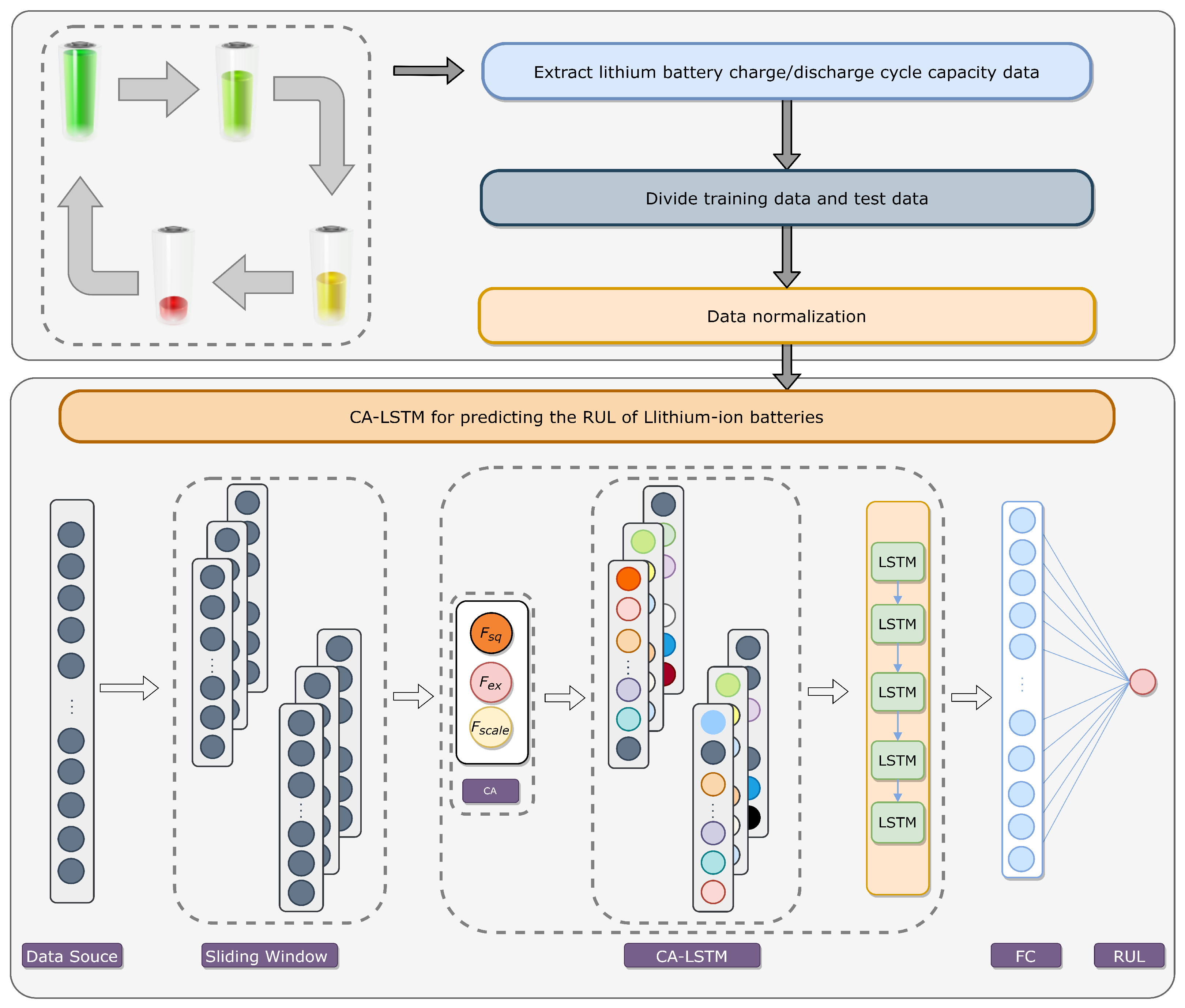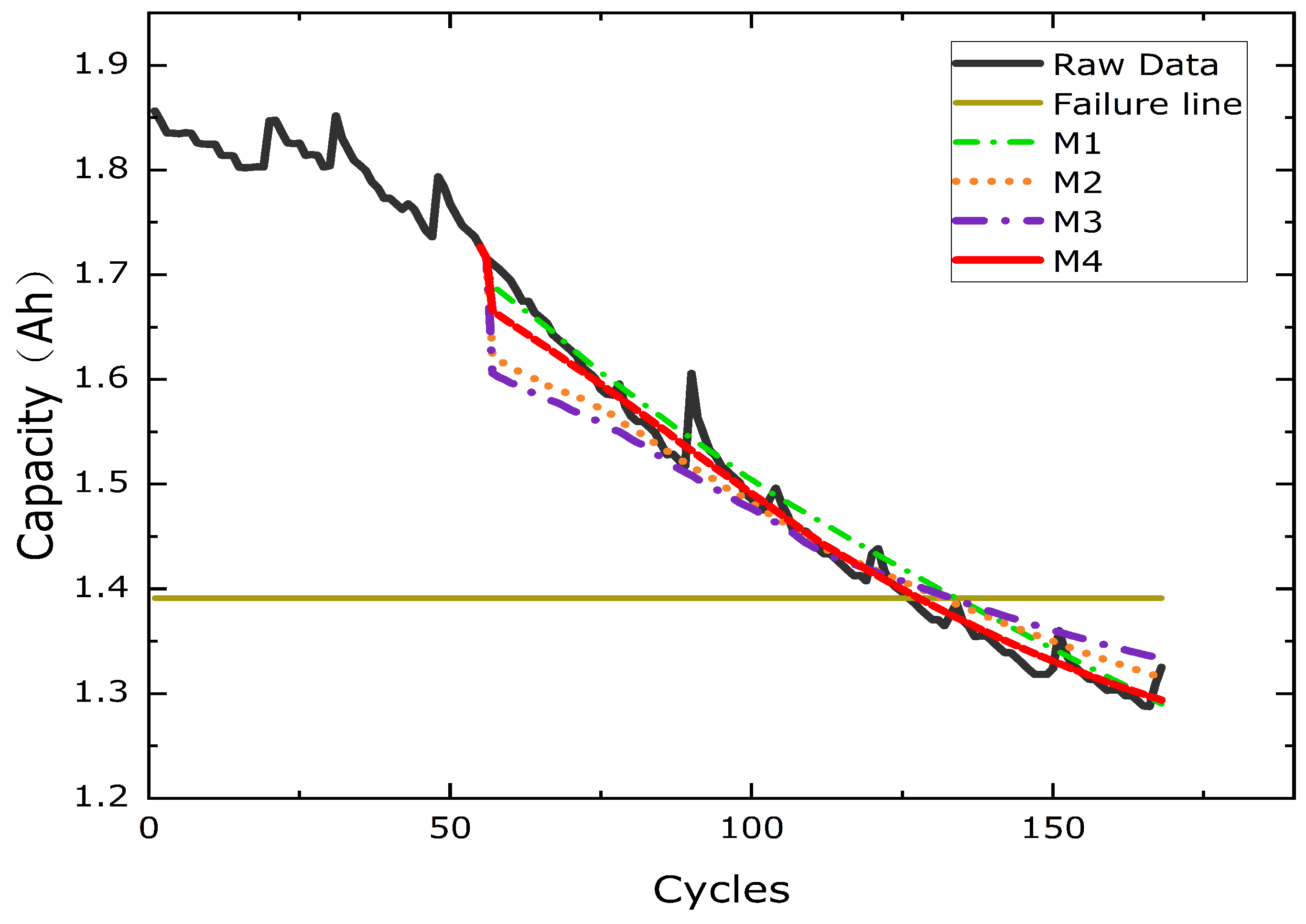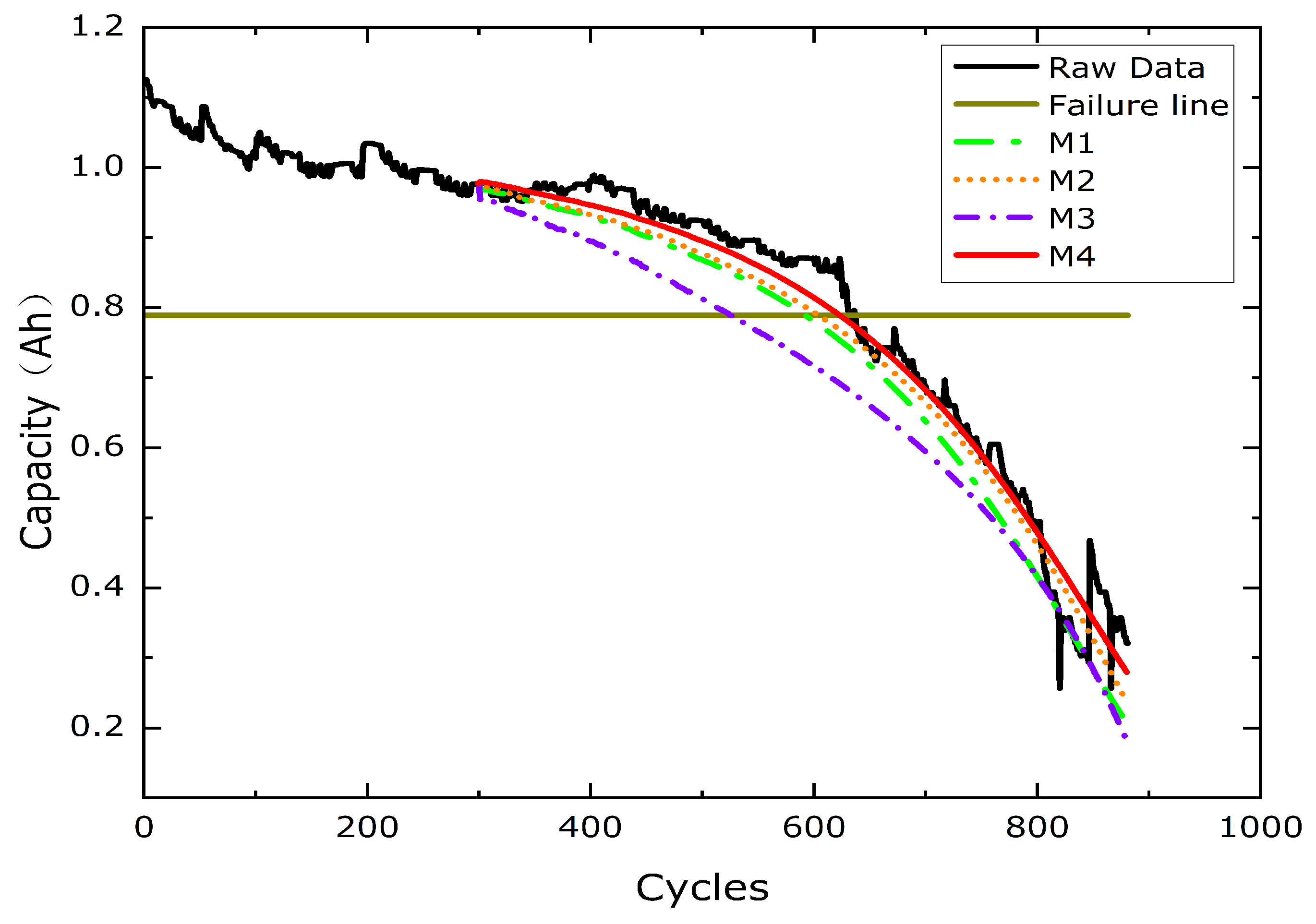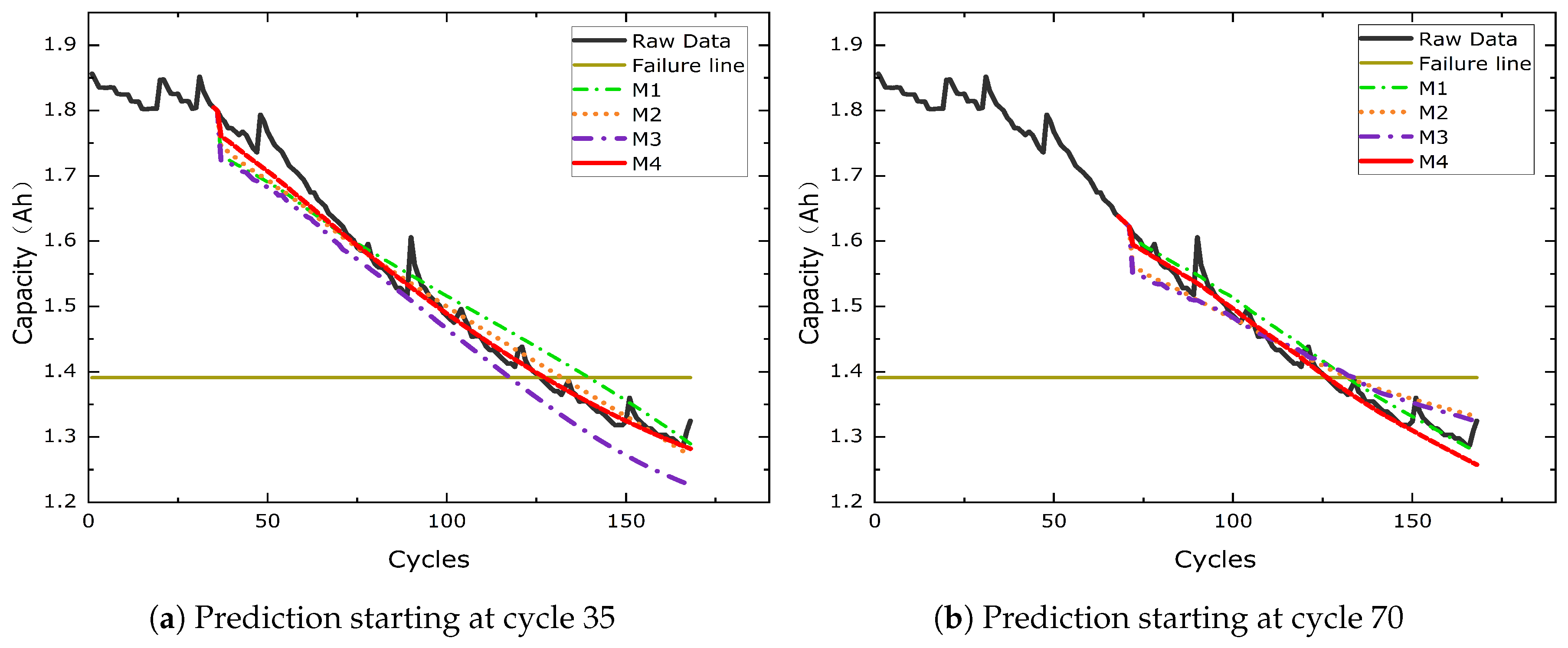Remaining Useful Life Prediction for Lithium-Ion Batteries Based on a Hybrid Deep Learning Model
Abstract
:1. Introduction
2. Model Building
2.1. LSTM
2.2. Attentional Mechanism
2.3. RUL Prediction Model with LSTM Based on a Channel Attention Mechanism
3. Data Sources and Experimental Settings
3.1. Data Introduction
3.2. Experiment Settings
3.3. Evaluation Criteria
4. Experiment Results and Analysis
4.1. Battery Life Prediction
4.2. Different Starting Points for Prediction
5. Conclusions
Author Contributions
Funding
Institutional Review Board Statement
Informed Consent Statement
Data Availability Statement
Conflicts of Interest
References
- Global Lithium Battery Industry Development White Paper 2023. Available online: https://www.shifair.com/informationDetails/86748.html (accessed on 23 February 2023).
- Chawla, N.; Bharti, N.; Singh, S. Recent advances in non-flammable electrolytes for safer lithium-ion batteries. Batteries 2019, 5, 19. [Google Scholar] [CrossRef] [Green Version]
- Li, W.; Jiao, Z.; Du, L.; Fan, W.; Zhu, Y. An indirect rul prognosis for lithium-ion battery under vibration stress using elman neural network. Int. J. Hydrogen Energy 2019, 44, 12270–12276. [Google Scholar] [CrossRef]
- Wu, L.; Liu, K.; Pang, H. Evaluation and observability analysis of an improved reduced-order electrochemical model for lithium-ion battery. Electrochim. Acta 2021, 368, 137604. [Google Scholar] [CrossRef]
- Gao, D.; Liu, X.; Zhu, Z.; Yang, Q. A hybrid cnn-bilstm approach for remaining useful life prediction of evs lithium-ion battery. Meas. Control 2023, 56, 371–383. [Google Scholar] [CrossRef]
- Li, X.; Ma, Y.; Zhu, J. An online dual filters rul prediction method of lithium-ion battery based on unscented particle filter and least squares support vector machine. Measurement 2021, 184, 109935. [Google Scholar]
- Li, S.; Fang, H.; Shi, B. Remaining useful life estimation of lithium-ion battery based on interacting multiple model particle filter and support vector regression. Reliab. Eng. Syst. Saf. 2021, 210, 107542. [Google Scholar] [CrossRef]
- Ji, Y.; Chen, Z.; Shen, Y.; Yang, K.; Wang, Y.; Cui, J. An rul prediction approach for lithium-ion battery based on sade-mesn. Appl. Soft Comput. 2021, 104, 107195. [Google Scholar] [CrossRef]
- Hu, X.; Xu, L.; Lin, X.; Pecht, M. Battery lifetime prognostics. Joule 2020, 4, 310–346. [Google Scholar]
- Khaleghi, S.; Hosen, M.S.; Karimi, D.; Behi, H.; Beheshti, S.H.; Van Mierlo, J.; Berecibar, M. Developing an online data-driven approach for prognostics and health management of lithium-ion batteries. Appl. Energy 2022, 308, 118348. [Google Scholar] [CrossRef]
- Ansari, S.; Ayob, A.; Lipu, M.H.; Hussain, A.; Saad, M.H.M. Remaining useful life prediction for lithium-ion battery storage system: A comprehensive review of methods, key factors, issues and future outlook. Energy Rep. 2022, 8, 12153–12185. [Google Scholar]
- Meng, H.; Li, Y. A review on prognostics and health management (phm) methods of lithium-ion batteries. Renew. Sustain. Energy Rev. 2019, 116, 109405. [Google Scholar]
- Chen, N.; Li, J.; Wang, Z.; Man, Y. Cause and analysis of lithium battery fire accident of B787-800 aircraft. Battery Bimon. 2022, 52, 204–207. [Google Scholar]
- Zhang, Z.; Liáng, S.; Yán, C. Research and suggestions for safe and orderly development of electrochemical energy storage in the context of carbon peak and carbon neutrality. Chin. Eng. Consult. 2021, 41–45. [Google Scholar]
- Liu, K.; Li, Y.; Hu, X.; Lucu, M.; Widanage, W.D. Gaussian process regression with automatic relevance determination kernel for calendar aging prediction of lithium-ion batteries. IEEE Trans. Ind. Inform. 2020, 16, 3767–3777. [Google Scholar] [CrossRef] [Green Version]
- Wang, S.; Fan, Y.; Jin, S.; Takyi-Aninakwa, P.; Fernandez, C. Improved anti-noise adaptive long short-term memory neural network modeling for the robust remaining useful life prediction of lithium-ion batteries. Reliab. Eng. Syst. Saf. 2023, 230, 108920. [Google Scholar] [CrossRef]
- Wei, Y.; Wu, D. Prediction of state of health and remaining useful life of lithium-ion battery using graph convolutional network with dual attention mechanisms. Reliab. Eng. Syst. Saf. 2023, 230, 108947. [Google Scholar]
- Jin, S.; Sui, X.; Huang, X.; Wang, S.; Teodorescu, R.; Stroe, D. Overview of machine learning methods for lithium-ion battery remaining useful lifetime prediction. Electronics 2021, 10, 3126. [Google Scholar] [CrossRef]
- Pang, X.; Huang, R.; Wen, J.; Shi, Y.; Jia, J.; Zeng, J. A lithium-ion battery rul prediction method considering the capacity regeneration phenomenon. Energies 2019, 12, 2247. [Google Scholar] [CrossRef] [Green Version]
- Sun, T.; Xia, B.; Liu, Y.; Lai, Y.; Zheng, W.; Wang, H.; Wang, W.; Wang, M. A novel hybrid prognostic approach for remaining useful life estimation of lithium-ion batteries. Energies 2019, 12, 3678. [Google Scholar] [CrossRef] [Green Version]
- Wang, F.; Amogne, Z.E.; Chou, J.; Tseng, C. Online remaining useful life prediction of lithium-ion batteries using bidirectional long short-term memory with attention mechanism. Energy 2022, 254, 124344. [Google Scholar]
- Ashwin, T.R.; Chung, Y.M.; Wang, J. Capacity fade modelling of lithium-ion battery under cyclic loading conditions. J. Power Sources 2016, 328, 586–598. [Google Scholar] [CrossRef] [Green Version]
- Prasad, G.K.; Rahn, C.D. Model based identification of aging parameters in lithium ion batteries. J. Power Sources 2013, 232, 79–85. [Google Scholar] [CrossRef]
- Virkar, A.V. A model for degradation of electrochemical devices based on linear non-equilibrium thermodynamics and its application to lithium ion batteries. J. Power Sources 2011, 196, 5970–5984. [Google Scholar] [CrossRef]
- Zhang, H.; Miao, Q.; Zhang, X.; Liu, Z. An improved unscented particle filter approach for lithium-ion battery remaining useful life prediction. Microelectron. Reliab. 2018, 81, 288–298. [Google Scholar] [CrossRef]
- Guha, A.; Patra, A. Online estimation of the electrochemical impedance spectrum and remaining useful life of lithium-ion batteries. IEEE Trans. Instrum. Meas. 2018, 67, 1836–1849. [Google Scholar] [CrossRef]
- Duong, P.L.T.; Raghavan, N. Heuristic kalman optimized particle filter for remaining useful life prediction of lithium-ion battery. Microelectron. Reliab. 2018, 81, 232–243. [Google Scholar] [CrossRef]
- Walker, E.; Rayman, S.; White, R.E. Comparison of a particle filter and other state estimation methods for prognostics of lithium-ion batteries. J. Power Sources 2015, 287, 1–12. [Google Scholar] [CrossRef] [Green Version]
- Li, X.; Peng, L.; Gao, L.; Bi, D.; Xie, X.; Xie, Y. A robust hybrid filtering method for accurate battery remaining useful life prediction. IEEE Access 2019, 7, 57843–57856. [Google Scholar] [CrossRef]
- Fan, L.; Wang, K.; Qian, C. Remaining Useful Life Prediction of LitlIium Battery Based on Physics of Failure and particle Filtering. J. Ordnance Equip. Eng. 2020, 41, 171–175. [Google Scholar]
- Zhao, J.; Zhu, Y.; Zhang, B.; Liu, M.; Wang, J.; Liu, C.; Hao, X. Review of state estimation and remaining useful life prediction methods for lithiumndash;ion batteries. Sustainability 2023, 15, 5014. [Google Scholar] [CrossRef]
- Chen, X.; Yang, H.; Wun, J.; Wang, C.; Li, L. Life prediction of lithium-ion battery based on a hybrid model. Energy Explor. Exploit. 2020, 38, 1854–1878. [Google Scholar] [CrossRef]
- Wang, P.; Zhang, X.; Zhang, G. Remaining useful life prediction of lithium-ion batteries based on resnet-bi-lstm-attention model. Energy Storage Sci. Technol. 2023, 12, 1215. [Google Scholar]
- Liu, J.; Chen, Z. Remaining useful life prediction of lithium-ion batteries based on health indicator and gaussian process regression model. IEEE Access 2019, 7, 39474–39484. [Google Scholar] [CrossRef]
- Chen, L.; Zhang, Y.; Zheng, Y.; Li, X.; Zheng, X. Remaining useful life prediction of lithium-ion battery with optimal input sequence selection and error compensation. Neurocomputing 2020, 414, 245–254. [Google Scholar] [CrossRef]
- Jia, J.; Liang, J.; Shi, Y.; Wen, J.; Pang, X.; Zeng, J. Soh and rul prediction of lithium-ion batteries based on gaussian process regression with indirect health indicators. Energies 2020, 13, 375. [Google Scholar] [CrossRef] [Green Version]
- Deng, L.; Shen, W.; Wang, H.; Wang, S.-Q. A rest-time-based prognostic model for remaining useful life prediction of lithium-ion battery. Neural Comput. Appl. 2021, 33, 03. [Google Scholar]
- Jiang, B.; Dai, H.; Wei, X.; Jiang, Z. Multi-kernel relevance vector machine with parameter optimization for cycling aging prediction of lithium-ion batteries. IEEE J. Emerg. Sel. Top. Power Electron. 2023, 11, 175–186. [Google Scholar] [CrossRef]
- Wang, Z.; Ma, Q.; Guo, Y. Remaining useful life prediction of lithium-ion batteries based on deep learning and soft sensing. Actuators 2021, 10, 234. [Google Scholar] [CrossRef]
- Qiong, L.; Bao, Z. Remaining useful lifetime prediction for lithium battery based on GBDT algorithm. J. Electron. Meas. Instrum. 2022, 36, 166–172. [Google Scholar]
- Ren, L.; Sun, Y.; Cui, J.; Zhang, L. Bearing remaining useful life prediction based on deep autoencoder and deep neural networks. J. Manuf. Syst. 2018, 48, 71–77. [Google Scholar] [CrossRef]
- Chen, D.; Zheng, X.; Chen, C.; Zhao, W. Remaining useful life prediction of the lithium-ion battery based on cnn-lstm fusion model and grey relational analysis. Electron. Res. Arch. 2023, 31, 633–655. [Google Scholar] [CrossRef]
- Liao, Z.; Yu, L.; Li, S.; Zhou, P.; Zhang, A.; Li, C. Remaining Life Prediction of Lithium Battery Based on Stochastic Configuration Network. Modul. Mach. Tool Autom. Manuf. Tech. 2022, 146–150. [Google Scholar]
- Khumprom, P.; Yodo, N. A data-driven predictive prognostic model for lithium-ion batteries based on a deep learning algorithm. Energies 2019, 12, 660. [Google Scholar] [CrossRef] [Green Version]
- Hochreiter, S.; Schmidhuber, J. Long Short-Term Memory. Neural Comput. 1997, 9, 1735–1780. [Google Scholar] [CrossRef] [PubMed]
- Jeong, M.; Park, M.; Nam, J.; Ko, B.C. Light-weight student lstm for real-time wildfire smoke detection. Sensors 2020, 20, 5508. [Google Scholar] [CrossRef]
- Al-azazi, F.A.; Ghurab, M. Ann-lstm: A deep learning model for early student performance prediction in mooc. Heliyon 2023, 9, e15382. [Google Scholar] [CrossRef]
- Liu, J.; Cheng, K.; Jin, H.; Wu, Z. An image captioning algorithm based on combination attention mechanism. Electronics 2022, 11, 1397. [Google Scholar] [CrossRef]
- Wang, D.; Xiang, S.; Zhou, Y.; Mu, J.; Zhou, H.; Irampaye, R. Multiple-attention mechanism network for semantic segmentation. Sensors 2022, 22, 4477. [Google Scholar] [CrossRef]
- Liu, J.; Yang, J.; Liu, K.; Xu, L. Ocean current prediction using the weighted pure attention mechanism. J. Mar. Sci. Eng. 2022, 10, 592. [Google Scholar] [CrossRef]
- Hu, J.; Shen, L.; Sun, G. Squeeze-and-excitation networks. In Proceedings of the 2018 IEEE/CVF Conference on Computer Vision and Pattern Recognition, Salt Lake City, UT, USA, 18–23 June 2018; pp. 7132–7141. [Google Scholar]
- Zhang, Z.; Zhang, W.; Yang, K.; Zhang, S. Remaining useful life prediction of lithium-ion batteries based on attention mechanism and bidirectional long short-term memory network. Measurement 2022, 204, 112093. [Google Scholar] [CrossRef]
- Wu, J.; Cheng, X.; Huang, H.; Fang, C.; Zhang, L.; Zhao, X.; Zhang, L.; Xing, J. Remaining useful life prediction of lithium-ion batteries based on pso-rf algorithm. Front. Energy Res. 2023, 10, 937035. [Google Scholar] [CrossRef]













| Battery | Constant Current Charge (A) | Cut off Current of Constant Voltage Charge (A) | Constant Current Discharge (A) | Cut off Voltaget of Discharge (V) | Average Life (Cycle) |
|---|---|---|---|---|---|
| B0005 | 1.50 | 0.02 | 2.00 | 2.70 | 113 |
| B0006 | 1.50 | 0.02 | 2.00 | 2.50 | |
| B0007 | 1.50 | 0.02 | 2.00 | 2.20 | |
| B0018 | 1.50 | 0.02 | 2.00 | 2.50 | |
| CS2_35 | 0.55 | 0.05 | 0.55 | 2.70 | 678 |
| CS2_36 | 0.55 | 0.05 | 0.55 | 2.70 | |
| CS2_37 | 0.55 | 0.05 | 0.55 | 2.70 | |
| CS2_38 | 0.55 | 0.05 | 0.55 | 2.70 |
| Model | Description |
|---|---|
| M1 | LSTM |
| M2 | GRU |
| M3 | RNN |
| M4 | CA-LSTM |
| DataSet | Prediction Starting Point | Model | RMSE | MAE | PError |
|---|---|---|---|---|---|
| NASA | 55 | M1 | 0.0275 | 0.0218 | 0.0471 |
| M2 | 0.0333 | 0.0253 | 0.0580 | ||
| M3 | 0.0416 | 0.0328 | 0.0471 | ||
| M4 | 0.0213 | 0.0145 | 0.0109 | ||
| CALCE | 300 | M1 | 0.0576 | 0.0491 | 0.0769 |
| M2 | 0.0439 | 0.0363 | 0.0333 | ||
| M3 | 0.1140 | 0.0896 | 0.1620 | ||
| M4 | 0.0355 | 0.0288 | 0.0118 |
| DataSet | Prediction Starting Point | Model | RMSE | MAE | PError |
|---|---|---|---|---|---|
| NASA | 35 | M1 | 0.0324 | 0.0261 | 0.0927 |
| M2 | 0.0372 | 0.0281 | 0.0421 | ||
| M3 | 0.0308 | 0.0239 | 0.0506 | ||
| M4 | 0.0251 | 0.0179 | 0.0084 | ||
| 70 | M1 | 0.0245 | 0.0200 | 0.0602 | |
| M2 | 0.0379 | 0.0307 | 0.0694 | ||
| M3 | 0.0286 | 0.0237 | 0.0972 | ||
| M4 | 0.0178 | 0.0132 | 0.0139 | ||
| CALCE | 200 | M1 | 0.0579 | 0.0442 | 0.0565 |
| M2 | 0.0727 | 0.0635 | 0.1182 | ||
| M3 | 0.0593 | 0.0514 | 0.0879 | ||
| M4 | 0.0379 | 0.0313 | 0.0245 | ||
| 400 | M1 | 0.0502 | 0.0429 | 0.0893 | |
| M2 | 0.0478 | 0.0356 | 0.0315 | ||
| M3 | 0.0506 | 0.0382 | 0.0452 | ||
| M4 | 0.0401 | 0.0309 | 0.0231 |
Disclaimer/Publisher’s Note: The statements, opinions and data contained in all publications are solely those of the individual author(s) and contributor(s) and not of MDPI and/or the editor(s). MDPI and/or the editor(s) disclaim responsibility for any injury to people or property resulting from any ideas, methods, instructions or products referred to in the content. |
© 2023 by the authors. Licensee MDPI, Basel, Switzerland. This article is an open access article distributed under the terms and conditions of the Creative Commons Attribution (CC BY) license (https://creativecommons.org/licenses/by/4.0/).
Share and Cite
Chen, C.; Wei, J.; Li, Z. Remaining Useful Life Prediction for Lithium-Ion Batteries Based on a Hybrid Deep Learning Model. Processes 2023, 11, 2333. https://doi.org/10.3390/pr11082333
Chen C, Wei J, Li Z. Remaining Useful Life Prediction for Lithium-Ion Batteries Based on a Hybrid Deep Learning Model. Processes. 2023; 11(8):2333. https://doi.org/10.3390/pr11082333
Chicago/Turabian StyleChen, Chao, Jie Wei, and Zhenhua Li. 2023. "Remaining Useful Life Prediction for Lithium-Ion Batteries Based on a Hybrid Deep Learning Model" Processes 11, no. 8: 2333. https://doi.org/10.3390/pr11082333







